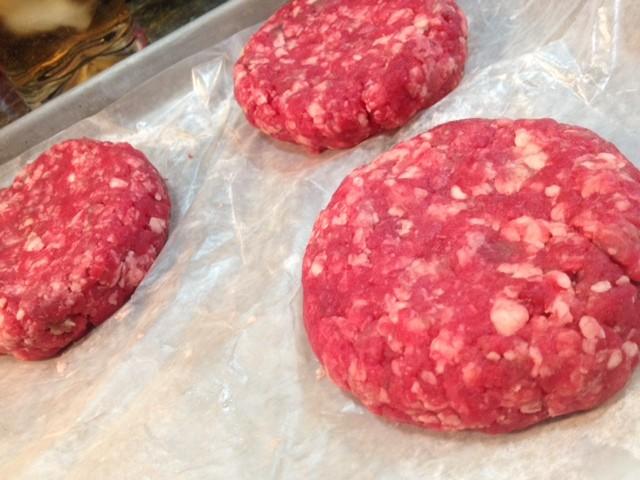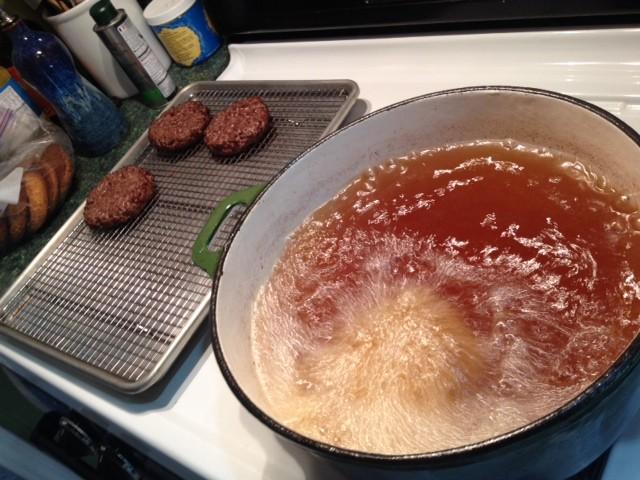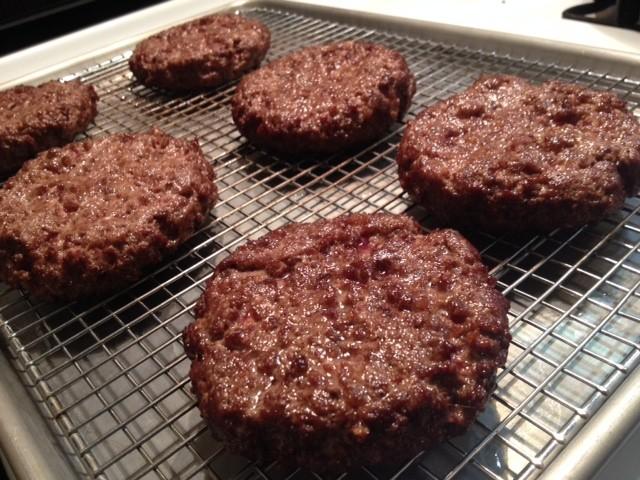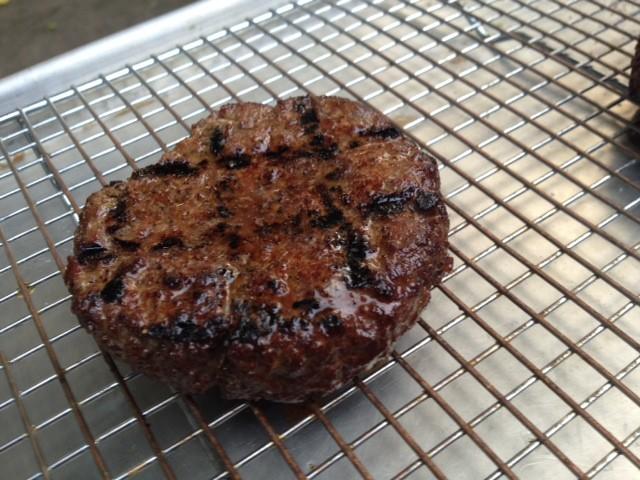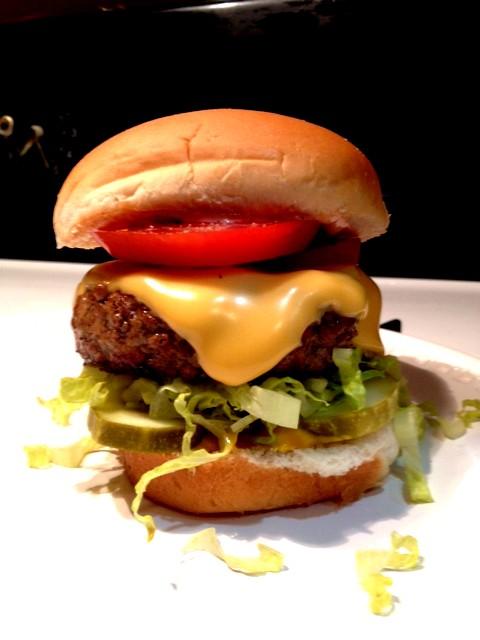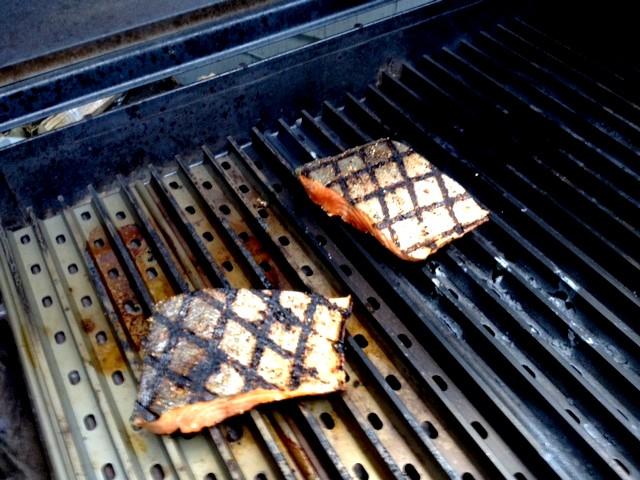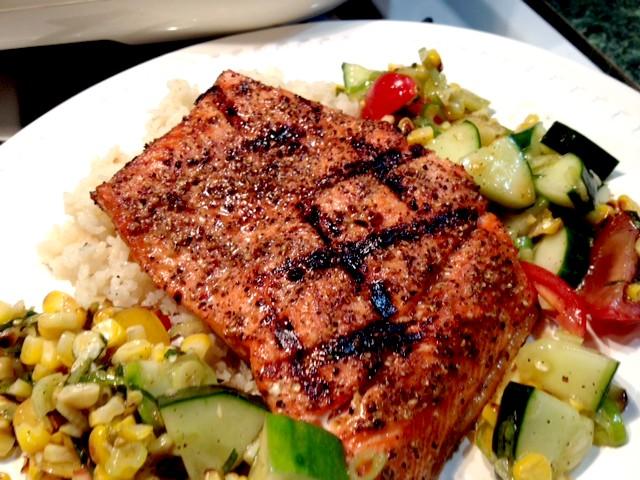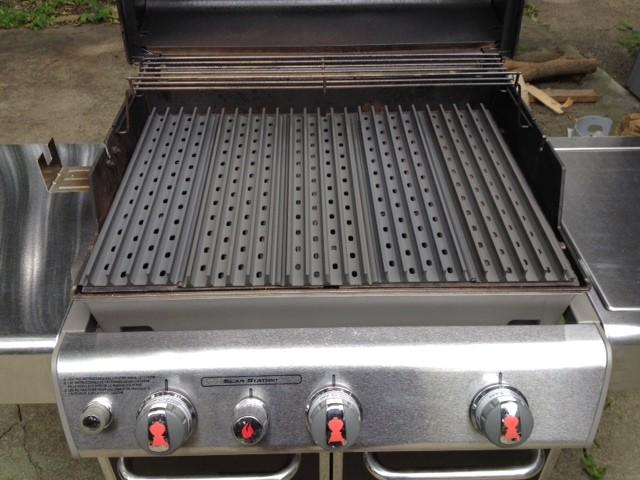-
Posts
1,807 -
Joined
-
Last visited
Content Type
Profiles
Forums
Store
Help Articles
Everything posted by btbyrd
-
Itty bitty eggplant parm.
-
I'm following the Dave Arnold protocol of fry-SV-grill (but with gas instead of charcoal). The reason I grill at the end instead of just deep frying is that I really like the flavor that comes off the grill. If you bag the burger with butter and drip the bag juices over the grill once it's scorching hot, you get that grilled meat flavor in a short amount of time. Straight up fried burger meat browns but doesn't have those vaporized fat/juice flavors. Here's tonight's progression with the brisket-shortrib-NYstrip blend. Post fry, pre-grill, Post grill, pre-bun. Bun. Yep, that's a Kraft single on top. I have some Kerrygold cheese waiting for some sodium citrate and carrageenan to make some melty slices for the weekend. I figured a fried SV grill burger was enough work for the middle of the week.
-
I recently got a meat grinder for my Kitchenaid and I've been experimenting with home-ground SV burgers. My technique is currently to cut meat into grinder-sized chunks, par freeze, (freeze the grinder beforehand), grind, form into patties, transfer to fridge for 30 minutes, transfer to freezer for 15 minutes. Then deep fry @ 375 for long enough to form a crust. Drain on rack. Transfer to a Ziplock bag with a pat of butter. Cook SV to your desired degree of doneness. Then sear off over a screaming hot grill. The results are awesome. No sausage-like texture, deep flavor, nice crust, extremely juicy. I've been using a 50/50 short rib/skirt steak blend but tonight am trying a 60/30/30 brisket/short rib/ny strip (trim from a subprimal I cut into steaks) blend. Should be good!
-
I've taken to using CatPoet's strategy and my results are much better than my previous attempts (which were more "foamies" than "smoothies"). Also, if you add anything like protein powder, do it at the end and blend in at low speed for just long enough to disperse the powder.
-
Kuhn Rikon makes a 12 quart unit that will work with induction. It'll do 7 pint or 5 quart jars. http://www.amazon.com/Kuhn-Rikon-12-Quart-Duromatic-Stockpot/dp/B001A0ER4E
-
I don't understand the point of ground Kobe/Wagyu when you can just use regular beef and grind in more fat. The real advantages are in whole muscle cuts and steaks. I've had Wagyu once - A6 from Australia - and it was impossibly decadent. Of course, it was layered with slices of smoked foie gras so that contributed even more richness.
-
Update #1: So far I've used Grill Grates 3 times - all for things I don't usually grill. Prior to using them the first time I seasoned them with flax seed oil. My first cook was 10 very fatty Italian sausages that coated the right side of my grill in a thick layer of pork fat. That side's very well seasoned now. The sausages got some very nice grill marks, cooked evenly, and there were no flareups but lots of sizzle and steam. It would have been hellfire if I used my standard grates (like I said... they were very fatty). I cooked them on my the lowest setting and the grill surface seemed significantly hotter than usual. The next time I flipped two of the grates over and used them as a plancha to sear off some sous vide beef cheek and hangar steak for pho. It worked pretty well, but I'm pretty sure that my pizza steel will work better as a flat top. I got a very nice sear. Last night I grilled some salmon, which I love but usually ends up getting somewhat mangled. Using the grate tool made flipping/turning the fish a total pleasure. There was no sticking at all. Due to the shape of the filets, I wasn't able to get even grill marks on the top side, but I imagine that cooking something like a swordfish or tuna steak (or some other cut of fish with flat surfaces) would produce fantastic results. Next time I'm going to add some wood pellets to add some smoke flavor while the meat grills. (The grates come with a sample packet of pellets, by the way.) On the grill: On the plate: Salmon with ChefSteps House Rub, basmati rice cooked in Modernist Cuisine vegetable stock, and a summer salad of baby heirloom tomatoes, grilled corn, cucumber, green onion, basil, olive oil, and sherry vinegar.
-
There's a pretty serious recipe in Japanese Soul Cooking by Tadashi Ono and Harris Salat. It's billed as being Bulldog-like, but better.
-
It's 5 of the 18.5" grates on top of the original enameled cast iron ones. There's about 3/4 of an inch of extra space in front and back so that they don't completely cover the factory grates (and they can't quite sit on the shelf/ledge that holds the grates). You can order 19.5" ones, but I've read that the grates stick up so much that there's an issue closing them. I've also seen images of Grill Grates that have a bevel cut into the grates so the grates sticking up are cut at an angle, which would probably solve the issue. I thought about ordering a custom cut set, but that would have been more expensive and I didn't think it was worth it (for me).
-
They just showed up! A near perfect fit. Too bad the rain showed up shortly after the FedEx guy. Hopefully I'll be able to break them in this weekend. Thanks again rotuts for the coupon code!
-
Leave bunsen burners out of it. It's not a difficult ingredient to use and is no more strange than something like sodium bicarbonate. You don't have to sweat bullets to use it... it's really quite simple. The fact that you can create cheese dips, sauces, fondue, and melty slices from high quality cheeses feels like magic the first time you do it. You can make a grilled cheese sandwich with Manchego and fig preserves and have it come out gooey and melty as if it were made with Kraft American Singles. That's pretty baller. And don't get me started on the queso you can make! The taste of artisan cheeses is amazing, but their melting properties suck. But thankfully that's nothing a little sodium citrate (or sodium hexametaphosphate) can't fix.
-
I'll post a pic once they show up. My plan is just to use them on top of my regular grates, but I did briefly contemplate getting a custom set cut to replace my current grates outright. An online specialty shop carries 19.5" grates that are designed for use on the Genesis, but I heard user reports that the raised grates come up so far that the lid won't close properly. They suggested cutting a bevel into the front of the grates, but that sounded like a lot of work and it would have been more expensive. So I'll have to live with losing an inch or so of grilling space (not that that's a big deal). GG recommends leaving extra room to allow for air circulation anyway.
-
Just ordered a set of 5 (thanks again to rotuts for the coupon code!) along with the modernist Baking Steel. I'll report back once I break them in. My porcelain enameled cast iron grates on my Weber Genesis E330 are super rusty after just one year; it'll be nice not to have to worry about rust anymore.
-
I asked Dave Arnold about garlic and chamber vacs on an episode of Cooking Issues (it's the first segment in this episode). Long story short... as long as you're refrigerating it, there's not really an issue with using garlic in a chamber vac - especially if you're just doing it for short times (like with a marinade). The same goes for quick pickling. You have to do quick pickles at the last minute (or close to it) because they'll become soggy and sad if you try to keep them for very long. You won't have pickles in there for long enough for botulism spores to grow, so go nuts. And like Shalmanese says, the main reason not to include garlic in sous vide recipes is that the temps are too low to break down plant materials, so you'll end up with basically raw (crunchy) garlic if you do it that way. If all you're doing is marinating before a traditional cook step (which is a great technique, by the way) then use the garlic don't worry about it.
-
Vaporized juices are one thing; a grease fire is another. I think the idea is that the juices will still vaporize when they hit the aluminum, but you don't have to worry about fat catching on fire and burning your food.
-
Those are basically the same reasons I'll be ordering as well. Reduced flareups from burgers will be nice and I'll finally be able to grill chicken skin-on without freaking out from the grease fire. It will also be good to use my grill's rotisserie without removing the grates (since the Grill Grates will prevent fat from hitting the burners). I also like the ability to reach under the food to lift it (fish!) and the fact that foods won't fall through the grates and into the fire. And using it while inverted as a griddle seems pretty handy. The reason I'm looking into Grill Grates for steaks and burgers is that I really love the flavor that comes from using a grill as opposed to a pan or cast iron griddle. Cast iron can produce a good result, but it's not really what I'm looking for. The flavor from the vaporized juices is what I find most delicious about grilled proteins. I'm also intrigued by how many people seem to win steak competitions while using this product. Anyway, I'm sure I'll find out soon enough... I'll be ordering a set once my paycheck comes in (along with a pizza steel). Thanks for the tip about the coupon! I don't have charcoal, but my gas grill can reach 700+ (and even hotter at the grates). That seems plenty hot for searing purposes. Do you ever use yours to finish off sous vide meats? I love SV grilling, but I get major flareups from fatty cuts like ribeye. Grill Grates seem like a good solution to this problem. I'm thinking that my SV steak workflow will eventually be presear with a Searzall --> bath --> screaming hot Grill Grates with a few wood pellets. Sounds about right to me.
-
I think I'm about to pull the trigger and buy a set of these, but I'm curious about how they really perform. I'm sure they'll almost eliminate flareups and that alone is pretty special. But how well does it really work when it comes to searing off steaks? From photos, I can see that they produce great grill marks, but the spaces in between the grates don't seem to brown especially well. I'm also curious how the flat side works for things like bread and pizza. I'm also probably about to pick up a pizza steel from BakingSteel.com and don't want to double up on functionality. My hunch is that it would be pretty badass to use a steel sitting on top of Grill Grates sitting on top of my enameled cast iron grates. But at that point, I'd be spending almost $300 for hunks of metal to put in a grill (if I get 5 GGs to completely cover my existing grates). That's a lot of change just to pimp my grill.
-
ChefSteps has a great set of videos showing you the texture of short ribs at various time/temp combinations.
-
Stainless for pretty much everything. I like to have a wooden spoon/scraper for cooking on enameled cast iron and non-stick surfaces. Same goes for turners... I like stainless for most applications but have a Matfer turner made of polyamid plastic that I use with my nonstick pan. I only use nonstick for cooking eggs and some types of fish, so 95% of the time I'm reaching for stainless.
-
The focus on CP Foods is misguided and overly narrow. I'm not trying to get CP off the hook for anything, but the problem extends far beyond that particular firm and their practices. Even if CP displayed due diligence in sourcing their products (maybe they did, maybe they didn't) it would be extremely difficult if not impossible to ensure that their products were free of slavery or forced labor. Let's look at the broader context. The largest and most systematic survey of the Thai fishing industry's labor practices is this study jointly conducted by the International Labour Organization and the Asian Research Center for Migration. The study interviewed 596 fisherman and found that 17% of respondents were working against their will and unable to leave because of threats of penalties (either physical violence, financial penalties, or governmental penalties for undocumented/illegal migrant workers). 5.4% did not enter the fishing sector voluntarily but were forced into it by manipulative handlers. Coercive and deceptive hiring practices are pervasive, especially amongst long-haul fishermen who journey into international waters. Forced labor and human trafficking were found to disproportionally impact migrant workers who immigrate from nearby Myanmar and Cambodia (which are both plagued by economic stagnation and political turmoil). These displaced workers move to Thailand to seek economic opportunities that do not exist in their homeland, but are unable to enter Thailand legally due to strict laws governing immigration. They are often trafficked into the country by exploitative guides who promise them jobs but deliver forced labor or outright slavery. Even those who are not trafficked in this way must sell their labor on the black market where there is no legal regulation. This offers still more opportunities for exploitation and coercive labor practices. Even domestic Thai workers are subjected to exploitative practices, largely because most workers (94%!!!!) had no written contract, and thus no way to estimate their wages, their occupational responsibilities, or the length of time they would be required to work. The lack of a contract also makes it difficult or impossible for exploited workers to challenge their employers in court. What's worse, widespread official corruption by government employees who are supposed to regulate this market and address worker complaints creates an atmosphere of hopelessness for victims of trafficking and forced labor. The upshot of this? The Thai fishing industry is systematically tainted by exploitation, corruption, and deceptive labor practices. You might suggest that companies simply stop buying fish from boats guilty of these sorts of injustice, but the supply chain for the industry is so muddied and obscured that it's this isn't feasible. Fish from different boats are mixed at sea, and are often mixed again at processing plants and ports. All this mixing happens before the larger companies even come into the picture to buy these products. Max Tunon (one of the authors of the ILO study) claims that it is "close to impossible" to disentangle Thailand's fish supply chains. This means that it's close to impossible to ensure that your products are exploitation/slavery free if you're buying fish meal in Thailand. If you're buying fishmeal in a commodity market where almost 1 in 5 fishermen are working against their will, there's not much that can feasibly be done. When CP Foods claims that they don't have visibility regarding the ultimate source of fish that their suppliers use to make fish meal, it's not "meaningless corporate babble." It's true. And even NGO non-profit worker's advocacy groups like the ILO acknowledge that it's true. There's no simple way to say "OK. Busted! We'll stop it!". And if you can come up with one, I'm sure that CP Foods, the ILO, and tens of thousands of Thai fishermen will be interested in what you have to say. Thailand is the world's third largest exporter of seafood, and the United States is the number one destination for exported Thai fish. 17% of fishermen in Thailand are working against their will. This problem is way bigger than the shrimp at Walmart and Aldi. Simply not buying foods from CP Foods will not solve the problem. Solving the problem will require liberalized immigration policies in Thailand, better enforcement (or just the existence) of contracts for fishermen, active governmental regulation/inspections, and a reduction of official corruption. It will require a coordinated effort by the Thai fish industry to render their supply chain more transparent and to improve the practices of the firms operating in the market. It will require a lot. Until things improve, don't buy seafood from Thailand. Don't just boycott a single firm; boycott their entire industry.
-
The article does not say that shrimp are gathered and processed by slaves. It doesn't even imply this. The key claim made in the article is this: "The investigation found that the world's largest prawn farmer, the Thailand-based Charoen Pokphand (CP) Foods, buys fishmeal, which it feeds to its farmed prawns, from some suppliers that own, operate or buy from fishing boats manned with slaves." The problem is that the fish used to create fish meal are commodity goods, and once they're off the boat it's impossible to differentiate them or track where they came from. As the CP Foods rep interviewed for the story says: "We're not here to defend what is going on. We know there's issues with regard to the [raw] material that comes in [to port], but to what extent that is, we just don't have visibility." That's extremely important to understand. Unless CP Foods produced its own fishmeal, it will be almost impossible for them to know exactly what the labor conditions are like for the fishermen who supply the inputs required to make the meal. Much of the problem is institutional and not a matter of the practices of a particular company. The government is failing to protect human rights so much so that Thailand is on the verge of being demoted to a tier-3 country on the human trafficing index. And the fishing industry in Thailand is especially bad in this regard. CP Foods have admitted that they know that some of their suppliers are using goods that were produced using slave labor. That isn't to say that they know which suppliers in particular are using slave labor, or how much of a particular supplier's output was created using slave labor. Finding out that information is extremely difficult. The article didn't even begin to speculate on how much of their supply chain depends on slavery. It might be half a percent; it might be 50%. We don't know. Neither do the authors of the article or CP Foods. Fishmeal producers aren't buying fish from just one boat; they're buying products from hundreds of boats. CP Foods isn't getting fishmeal from just one supplier, they're getting it from many suppliers. It would be one thing if every fish caught by a slave had a tag on it that said "Immorally Sourced Fish Product," but they don't. They just look like any other fish from any other boat. And once these fish get unloaded in a port, there's precious little that can be done to differentiate fish or fishmeal produced using slavery from items that were produced by free people. I never said that "it's cool" for this to happen or that it is permissible because "it's only indirect." I said there was no excuse. I also urged others to boycott those products and instead purchase substitutes that have a more transparent supply chain.
-
So throw "Trader Joe's" into the mix with Aldi and Walmart. Costco is a membership-based wholesale discount business. The name "Costco" should give you a clue that they're trying to offer goods to consumers at low prices; the chain's original name was "Price Club." Not that it really matters...
-
This is a terrible story, but to be fair the article doesn't say that the shrimp are "gathered and processed" by slaves. It also doesn't say that CP Foods directly employs slave labor. The claim is that some of the fish used to make the fish-meal-based feed for CP Food's shrimp farms are caught by slaves. Fishing boat owners own the slaves who catch the fish, and that fish is then sold to factories to make fish meal... which is then sold to CP Foods to feed their shrimp. I wonder how difficult it is to source ethically produced fish meal in Thailand given that (according to the article) 90% of the labor pool for commercial fishing operations consists of migrants who are vulnerable to exploitation. Of course, difficulty in obtaining slavery-free feed is no excuse for using feed produced by slaves. It just seems that Thailand's fishing industry is screwed up generally. I'm with HungryC on this one. This is just another reason to purchase wild-caught items with a supply chain you can trust. Depending on where you live though, this can be an expensive proposition (not all of us live in southern Louisiana!). I imagine that most people who buy frozen shrimp at Aldi, Costco, and Walmart don't have much extra money to put toward higher quality shrimp. But I for one balk at the idea of cooking frozen shrimp that were farmed thousands of miles away by people with unscrupulous business practices. It's much better to buy a better product whose pedigree you know, or else to abstain from using shrimp altogether.
-
I use a rice cooker because it produces great results and you don't have to keep an eye on it. Morimoto uses one on Iron Chef whenever he makes rice and Dave Arnold swears by his. Not saying you can't do it other ways, but if you cook a lot of rice and have the space, rice cookers are the way to go.
-
SV is my preferred reheating method for pretty much all proteins, but it can be tricky if you're dealing with stuff that's been sliced into smaller pieces (as I imagine your duck is). If you have larger cuts like a steak or a duck leg, it's easy to retherm them and sear them off to refresh your crust. That's not as easy when you've got slices of meat that you're trying to reheat that you also want a nice crust on. If they're big enough to stand up on their own without flopping over, I'd say reheat SV and then sear the skin side to get it crispy again. If the slices are too thin for that, you might have to put up with some less-than-crispy skin or else just put it in a hot oven (or maybe even under a broiler) until it perks up. Getting once-crispy skin crispy again is a tough task that usually involves overcooking the rest of your item. Leftovers are tricky that way. I have a feeling that once the Searzall finally ships, it will be a great way to put finishing touches on your SV-warmed leftover duck. (But that's just conjecture at this point!)




